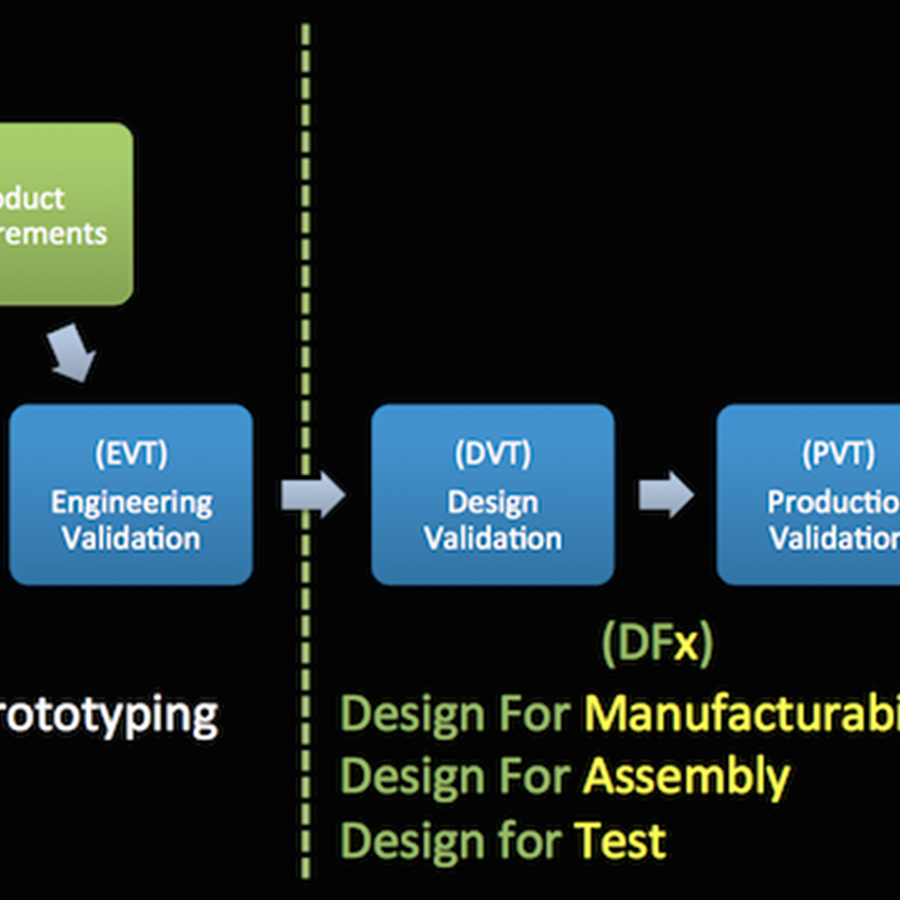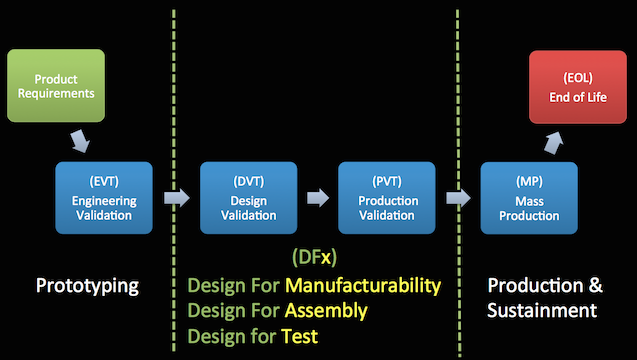MAKE IT IN LA advisor Michael Corr shares practical tips for designing electrical engineering systems, from his recent talk at the MAKE IT IN LA event December 1st. From the talk, it’s clear how important design can be in preparing to take your product to scale. Check out Durolabs’ blog for more columns about manufacturing and design.
Last Thursday night was a lot of fun presenting at the LACI and MAKE IT IN LA event celebrating the opening of their Advanced Prototyping Center. I had the honor of presenting to a sold out audience on a topic that is important to me: DFx for Electrical Engineering.
In my talk I started by outlining the various stages of a product’s lifecycle. But, the focus of the presentation was on the middle phase, or the “meat” of product development – crossing the chasm from prototype to full production.
There are a lot of steps required to get a product ready for production after a prototype has been developed – and it’s crucial that adequate DFX guidelines are implemented to help guarantee a successful product launch.
What is DFX? In short, it is a term used to capture the multiple facets of making design decisions for someone or something else. Design For X. Where “X” is one of the following:
- Design for Manufacturability – Designing a component so that it can be manufactured or fabricated in an efficient and cost effective manner.
- Design for Assembly – Designing an assemblage feature so that multiple components can be assembled together in a reliable and cost effective manner.
- Design for Testing – Incorporating features to make it simple and efficient to test the functionality of a product in a timely and cost effective manner.
Mature engineers and product developers recognize that it takes a village to make a product. There are multiple stages to manufacturing and no one person can do them all, nor become experts in each stage.
But, once someone becomes educated enough on the basics of what steps are required in another stage of the product manufacturing ecosystem, then they can show empathy for the persons performing those tasks, and they themselves can make better decisions to ensure the success of others.This is what DFX is about. Making good design decisions so someone else (or thing) can do their job better. And the best way to make these decisions is to understand what tasks others will have to do when they receive the output of your work.
DFX applies to all disciplines, not just electrical engineering, but to keep the talk succinct I focused only on DFX for Printed Circuit Board Assemblies (PCBAs). Because electrical circuits can have 10’s to 1000’s of individual components assembled in very small and potentially complex networks of conductive traces, they inherently are complicated assemblies with the potential to incur very subtle defects.
What can go wrong with assembling PCBAs? The list is not short, but for brevity I’m highlighting the most common:
- Insufficient or too much solder application resulting in electrical opens or shorts, respectively
- Poor soldering causing “cold solder joints” which in turn result in temporal electrical connections or joints which fatigue over time from prolonged use and exposure to various environments
- Counterfeit or damaged components which are not caught before being assembled
- Valid parts incorrectly assembled into the product
One can implement as many design decisions as they want to prevent these potential issues, but the only way to know if the choices are making an impact is to actually measure it. For manufacturing, that metric is called yield.
Yield is a percentage of how many individual units in a production batch have passed all milestones and tests of the total batch size. Because of the potential complexity of products, and in my opinion PCBAs are the most complex, there is no guarantee that you will have 100% yield. But, through good implementation of DFX guidelines you can certainly increase your chances to get as close as possible.
The primary metric to use is called First Pass Yield (FPY). This is the only way to compare apples-to-apples. Conceptually, an individual product which fails a test could be reworked once or several times until it finally passes the test. Since this is too variable, the safest metric to use is how many units pass on their first test attempt, without any need for reworking; hence the term: First Pass Yield. Ideally you should aim for a first pass yield of at least 97%.
In Part 2 of this article I will discuss some more practical details of applying DFX principles in your PCBA design to achieve the kind of yields and outcomes you hope for.



